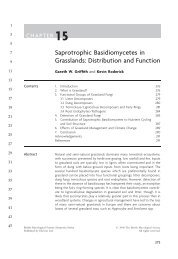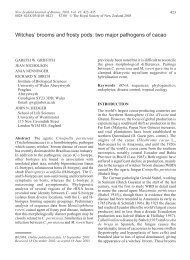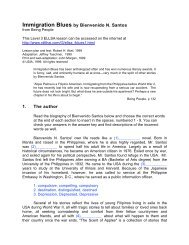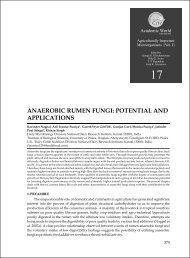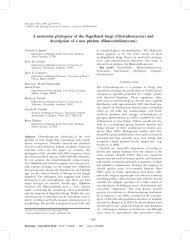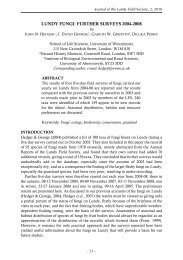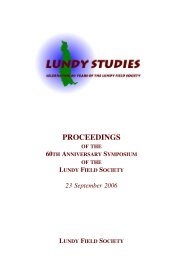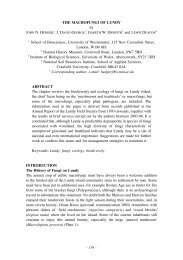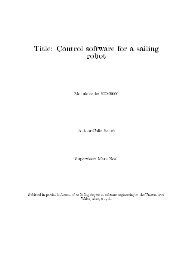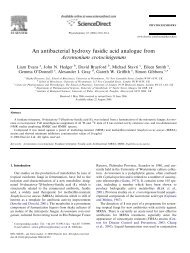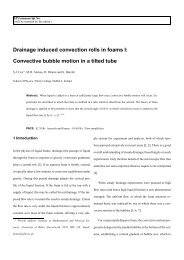Short and long-range visual navigation using warped panoramic ...
Short and long-range visual navigation using warped panoramic ...
Short and long-range visual navigation using warped panoramic ...
You also want an ePaper? Increase the reach of your titles
YUMPU automatically turns print PDFs into web optimized ePapers that Google loves.
<strong>Short</strong> <strong>and</strong> <strong>long</strong>-<strong>range</strong> <strong>visual</strong> <strong>navigation</strong> <strong>using</strong> <strong>warped</strong> <strong>panoramic</strong> images<br />
Abstract<br />
Frédéric Labrosse<br />
Department of Computer Science, University of Wales, Aberystwyth<br />
Aberystwyth, Ceredigion, SY23 3ET, United Kingdom<br />
In this paper, we present a method that uses <strong>panoramic</strong> images to perform <strong>long</strong>-<strong>range</strong> <strong>navigation</strong> as a succession of short-<strong>range</strong><br />
homing steps a<strong>long</strong> a route specified by appearances of the environment of the robot a<strong>long</strong> the route. Our method is different<br />
from others in that it does not extract any features from the images <strong>and</strong> only performs simple image processing operations. The<br />
method does only make weak assumptions about the surroundings of the robot, assumptions that are discussed. Furthermore, the<br />
method uses a technique borrowed from computer graphics to simulate the effect in the images of short translations of the robot to<br />
compute local motion parameters. Finally, the proposed method shows that it is possible to perform <strong>navigation</strong> without explicitly<br />
knowing where the destination is nor where the robot currently is. Results in our Lab are presented that show the performance of<br />
the proposed system.<br />
1. Introduction<br />
Visual <strong>navigation</strong> increasingly relies on local methods:<br />
paths are specified in terms of intermediate targets that<br />
need to be reached in succession to perform the <strong>navigation</strong><br />
task (Vassallo et al., 2002; Neal <strong>and</strong> Labrosse, 2004; Gourichon,<br />
2004). This task can thus be seen as a succession of<br />
homing steps.<br />
Many homing methods that use vision require the extraction<br />
of features from the images <strong>and</strong> their matching<br />
between successive images. This is for example the<br />
case of most methods derived from the snapshot model<br />
(Cartwright <strong>and</strong> Collett, 1983, 1987). A snapshot is a representation<br />
of the environment at the homing position,<br />
often a one-dimensional black <strong>and</strong> white image of l<strong>and</strong>marks<br />
<strong>and</strong> gaps between l<strong>and</strong>marks (Röfer, 1997; Möller<br />
et al., 1999), but also a two-dimensional image of l<strong>and</strong>marks<br />
such as corners (Vardy <strong>and</strong> Oppacher, 2003). Most<br />
of these methods use <strong>panoramic</strong> snapshots.<br />
Although feature extraction can be fast, it often requires<br />
assumptions about the type of features being extracted <strong>and</strong><br />
the world in which the robot is, in particular its structure<br />
(Gonzales-Barbosa <strong>and</strong> Lacroix, 2002). Natural environments<br />
often present no obvious <strong>visual</strong> l<strong>and</strong>marks or when<br />
Email address: ffl@aber.ac.uk (Frédéric Labrosse).<br />
1<br />
these exist, they are not necessarily easy to distinguish from<br />
their surroundings. The matching of features between successive<br />
images is often difficult <strong>and</strong> also requires many assumptions<br />
about the world surrounding the robot <strong>and</strong>/or<br />
the motion of the robot. Even currently widely used feature<br />
extraction methods such as the Harris detector or the Scale<br />
Invariant Feature Transform (SIFT) (Nistér et al., 2006;<br />
Lowe, 2004; Se et al., 2002) require expensive computation<br />
stages. Recently, Stürzl <strong>and</strong> Mallot (2006) have used the<br />
correlation of Fourier transformed 1D <strong>panoramic</strong> images<br />
to compute homing vectors. Although this offers a compact<br />
way of storing snapshots of the world (a few Fourier<br />
coefficients), this introduces additional computation (the<br />
Fourier transform).<br />
We propose to use raw images; this is the appearancebased<br />
approach (Labrosse, 2006; Binding <strong>and</strong> Labrosse,<br />
2006; Neal <strong>and</strong> Labrosse, 2004). Using whole twodimensional<br />
images rather than a few l<strong>and</strong>marks extracted<br />
from images or even 1D images (as in (Stürzl <strong>and</strong> Mallot,<br />
2006)) reduces aliasing problems; indeed, different places<br />
can look similar, especially if “seen” <strong>using</strong> only a few<br />
elements of their appearance.<br />
Only a few authors proposed to use raw images of some<br />
sort, e.g., Röfer (1997); Bisset et al. (2003); Neal <strong>and</strong><br />
Labrosse (2004); Gonzales-Barbosa <strong>and</strong> Lacroix (2002). An



